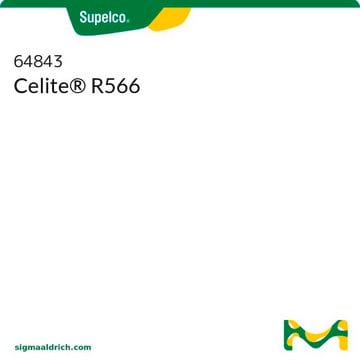22151
Celite® 503
filter aid, treated with sodium carbonate, calcined
Synonyme(s) :
Diatomaceous earth, flux-calcined
About This Item
Produits recommandés
Forme
powder
Qualité
calcined
treated with sodium carbonate
Composition
Al2O3, 4.0%
CaO, 0.5%
Fe2O3, 1.3%
Na2O + K2O, 3.3%
SiO2, 89.6%
Perte
~0.2% loss on ignition, 900 °C
Taille des particules
≤85.1 μm (80% (acc. to Cilas))
pH
>8.5 (25 °C, 10% in aq. suspension)
Chaîne SMILES
O=[Si]=O
InChI
1S/O2Si/c1-3-2
Clé InChI
VYPSYNLAJGMNEJ-UHFFFAOYSA-N
Vous recherchez des produits similaires ? Visite Guide de comparaison des produits
Catégories apparentées
Application
Attention
Informations légales
Mention d'avertissement
Danger
Mentions de danger
Conseils de prudence
Classification des risques
STOT RE 1 Inhalation
Organes cibles
Lungs
Code de la classe de stockage
6.1D - Non-combustible, acute toxic Cat.3 / toxic hazardous materials or hazardous materials causing chronic effects
Classe de danger pour l'eau (WGK)
WGK 1
Point d'éclair (°C)
Not applicable
Certificats d'analyse (COA)
Recherchez un Certificats d'analyse (COA) en saisissant le numéro de lot du produit. Les numéros de lot figurent sur l'étiquette du produit après les mots "Lot" ou "Batch".
Déjà en possession de ce produit ?
Retrouvez la documentation relative aux produits que vous avez récemment achetés dans la Bibliothèque de documents.
Les clients ont également consulté
Notre équipe de scientifiques dispose d'une expérience dans tous les secteurs de la recherche, notamment en sciences de la vie, science des matériaux, synthèse chimique, chromatographie, analyse et dans de nombreux autres domaines..
Contacter notre Service technique



